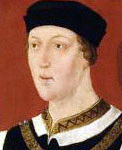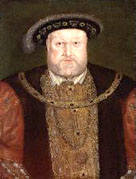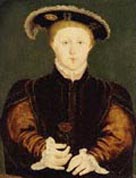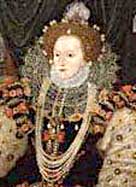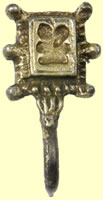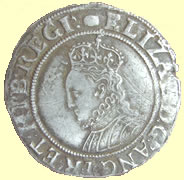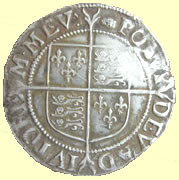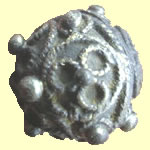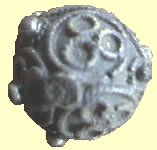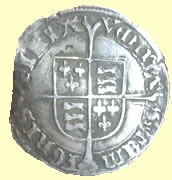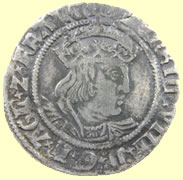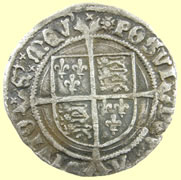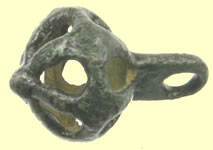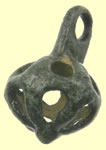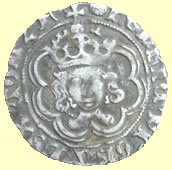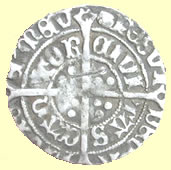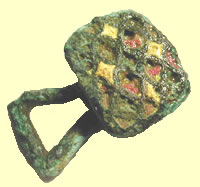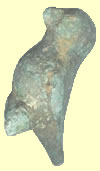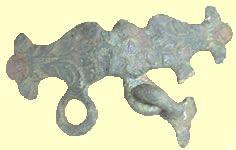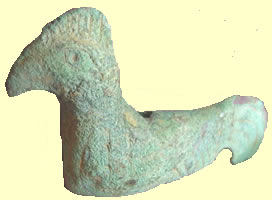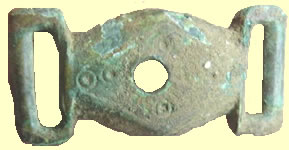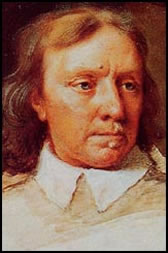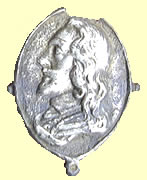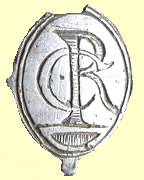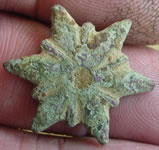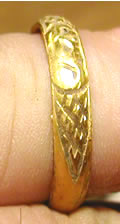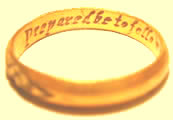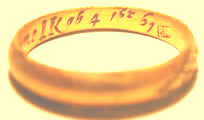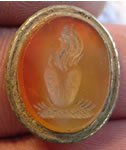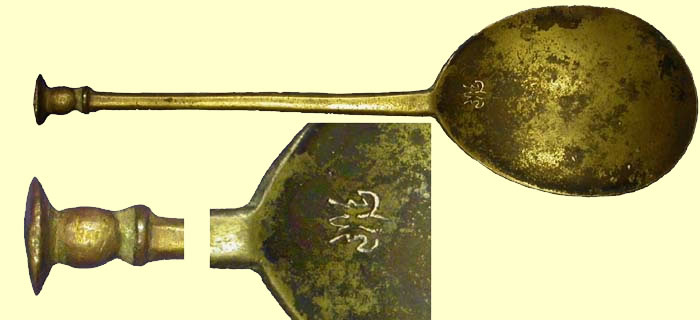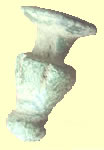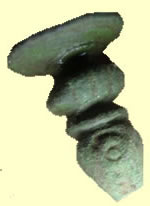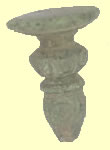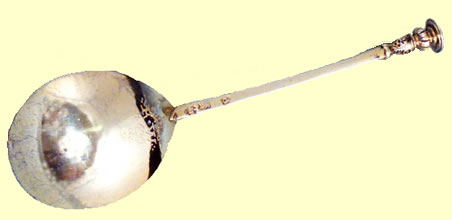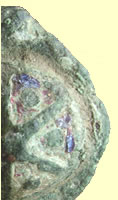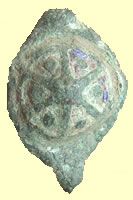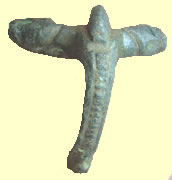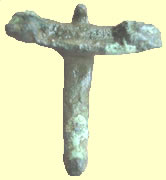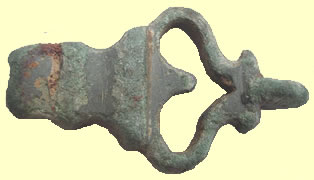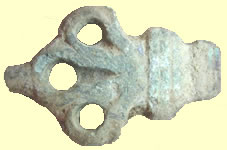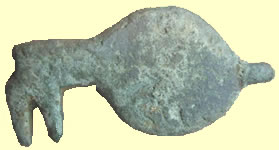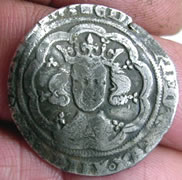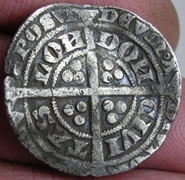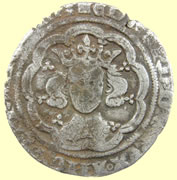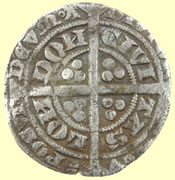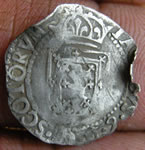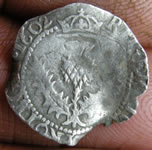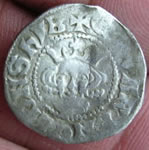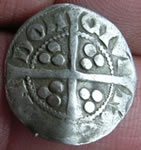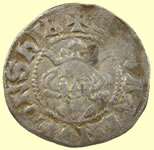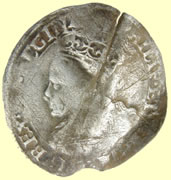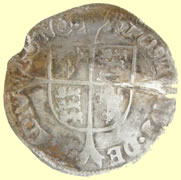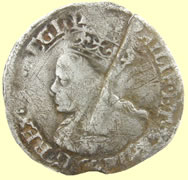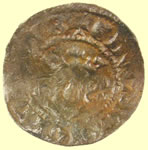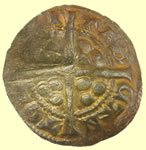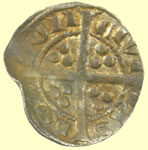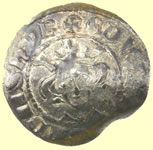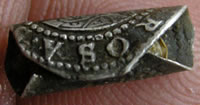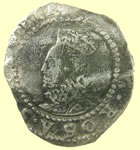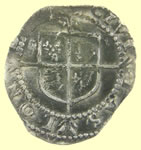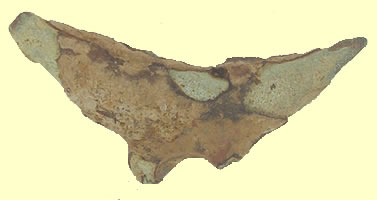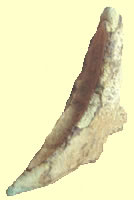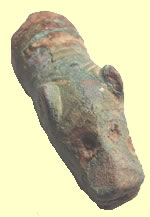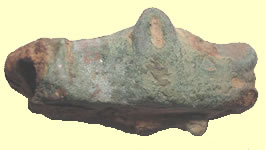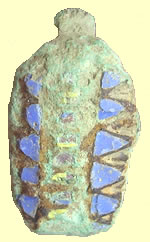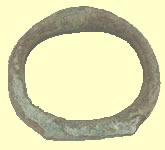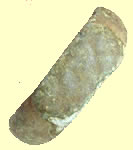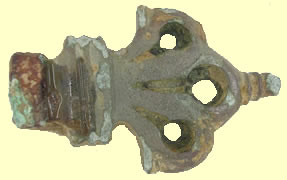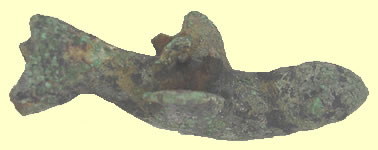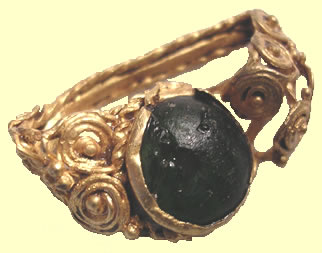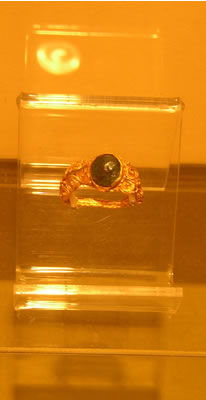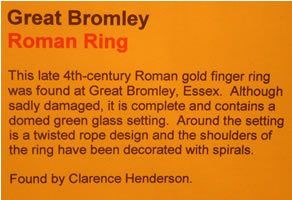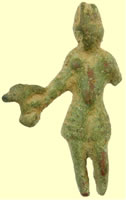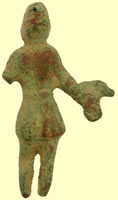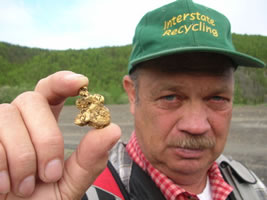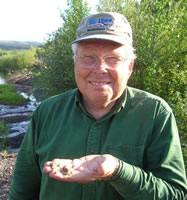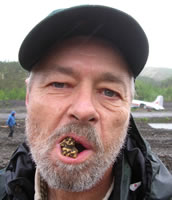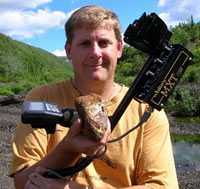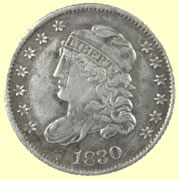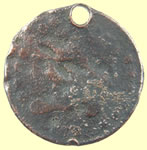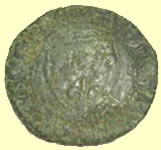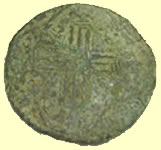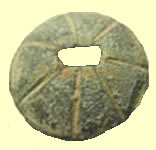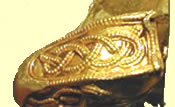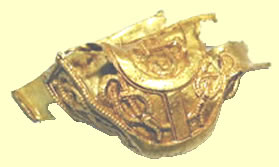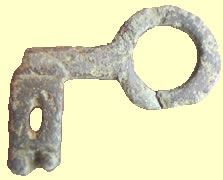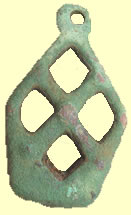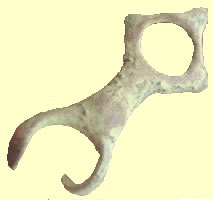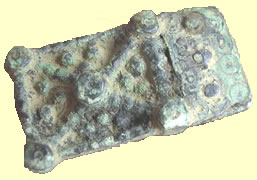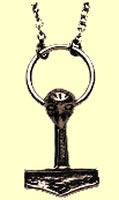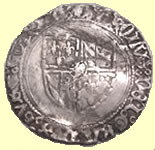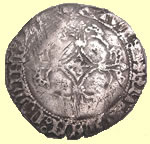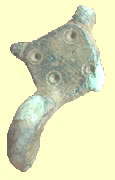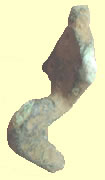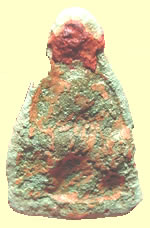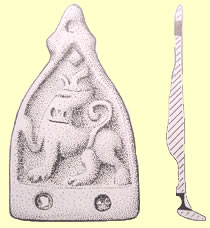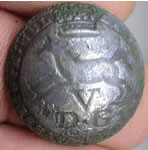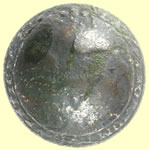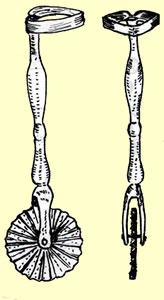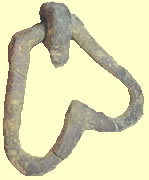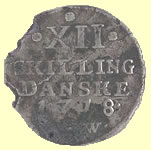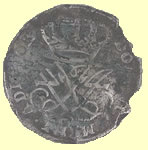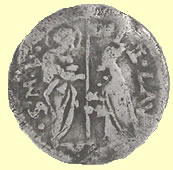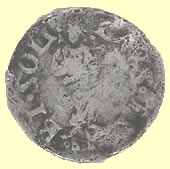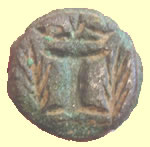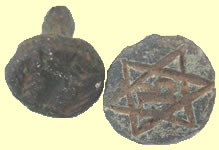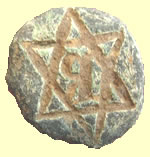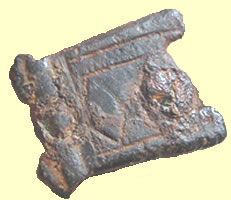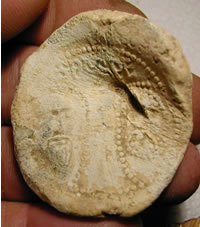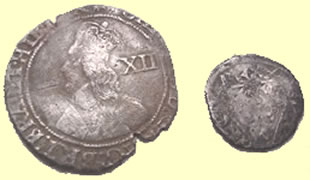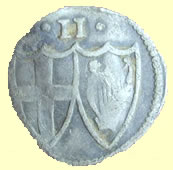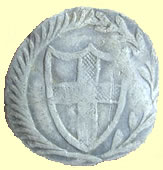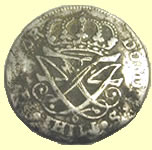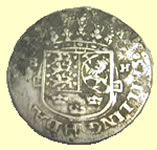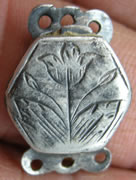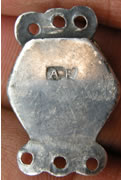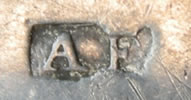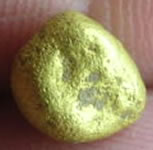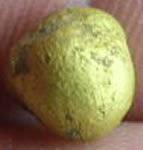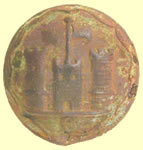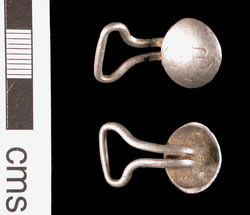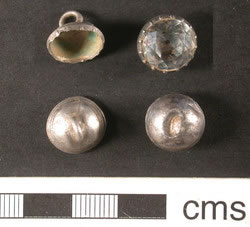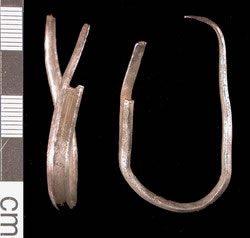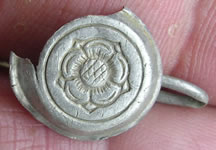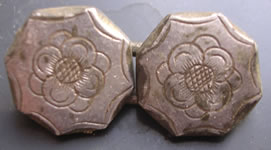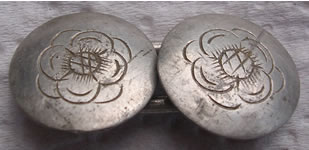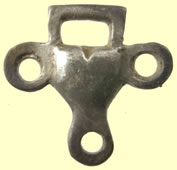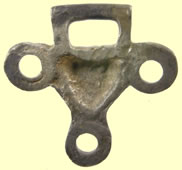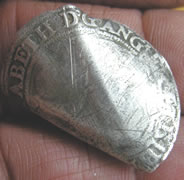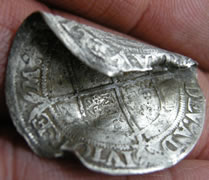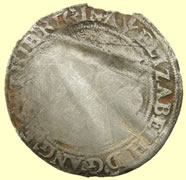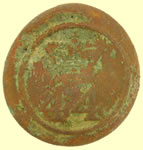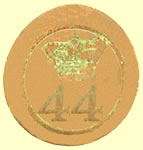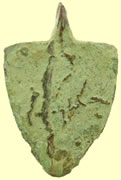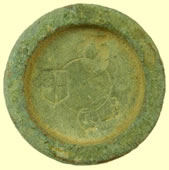

Metal detecting holidays in England with the World's most successful metal detecting club.
Twinned with Midwest Historical Research Society USA
8th Sept 2008 Skunking on the new land - great Roman find We hit some of the new land around an old Abbey yesterday and got totally skunked apart from the usual coppers and buttons. Florida Don had printed off a real old map showing one of the fields was an old park and all he got just 2 buttons off it. Luckily Atlanta Mike the first afternoon found a stonking Roman copper that he thought was a button until he washed it off in a puddle. I thought it was one of those 10% gold content type coins as it had a real copper toning. I sent it off to Mark Lehman the Roman expert and it originally had a silver wash is why it has that unusual colour. Mark sent us back a brilliant write up on the coin below. Florida Don found a completely different fibular looking brooch that I am going to research today, some real mice military button finds, 15thC tokens and do dads to post later.
No gold in this issue - the Romans may have used copper to debase gold (although, interestingly, unlike with the silver, they tended not to do this very much and instead struck smaller rather than debased gold coins in times of economic emergency) It certainly would have been "silvered", however - when new it would have had a wash of shiny white metal over the surface - this coating didn't last long and finding specimens of this era with any more than a trace of their silvering intact is very unusual.
This is "The Unfortunate Crispus", as history tends to style him. This eldest son of Constantine the Great by his 1st wife (before he was forced, for political reasons, to divorce her and marry Maximian's daughter) Crispus was having a brilliant career as a soldier and was extremely popular with the people. Constantine's 2nd wife (as the story goes) mother of the future emperors Constantine II, Constans and Constantius II, plotted to get rid of Crispus to clear the way for one or more of her sons to succeed Constantine. After she connived in concocting a story of rape and treason against Crispus, Constantine had him excecuted (there's some question here whether Crispus' popularity and military successes might not have been at least part of the great pragmatist, Constantine's, decision to do away with his own son).
Later, when Fausta's complicity in the plot was exposed, he had her sealed in a bath with a hypocaust beneath it, then had the fire stoked until she was boiled to death like a lobster.
This piece, from the Vota series, was struck at Siscia in 320 AD. The legends are thus:
Obv: IVL CRISPVS NOB CAES Laureate head right
Rx: CAESARVM NOSTRORVM around wreath, VOT / V within; GSIS (Siscia, 3rd officina) in exergue. RIC VII 151.
The "VOT V" is in proclamation of Crispus' undertaking the vows of his 5th year as a Caesar. The Emperor as Pontifex Maximus and "heirs apparent" Caesars as high priests of the State religion (despite Constantine and his family's official recognition of Christianity) undertook vows to perform certain ceremonies and sacrifices at various intervals (usually every 5 and/or 10 years) as sort of a bargain with the gods - "I'll faithfuly attend to doing these sacrifices for you if you'll keep me alive and in power for another 5 (or 10) years." Often appearing on reverses as merely VOT / V / MVLT / X (or X & XX, or XX & XXX, etc) within a wreath, this one honors the 3 Caesars created simultaneously 5 yrs before, Crispus, Constantine II, and Licinius II.
Mark
|
6th Sept 2008 Heeeeeeeha new season finally begins - more exports approved A few of the last exports arrived approved this morning - details posted on members forum. Finally the start of the new season has arrived, good luck to all the guys over the coming months. We have 30 or so new fields to try and hot spot plus another 200 or so fields from last season. We have just 3 Senior members for the first hunt so I will also get a chance to get out there and have good swing myself this week . It tough job but someone has to do it, all we have to do now is find something worth posting The Forum competition is now closed for entries. You can keep an eye on how you are doing as this is updated daily with the running total.
Uploaded more of our finds to the database |
3rd Sept 2008 Got the maps - More updates I went and picked up the maps for new land this morning that we can start searching from this Saturday. There appears to be 11 fields, some are monsters and other fairly manageable. The field I really like is right next to an early medieval church and is only 50 acres in size. I have sent the new maps off to Canadian Rod our historian to see what he can uncover on the history of the site, more details on members forum. The land conditions are still the best I have ever seen for a September start as there continues to be daily showers to keep the ground moist and compacted. The guys arriving Sat have already picked out a Celtic village site so we might get to hotspot this new land later in the week. I had a drive around the other sites and more fields have now been ploughed and rolled like pool tables. I have been doing some more research on the two very detailed serpent headed clasps we have found. The second one clearly shows that the clasp was riveted twice at one end, perhaps as a hooked strap end . I have seen them incorrectly attributed as S buckles, the museum's impression is they are Romano/British in date.
2 hooked strap ends ? - 16thC S belt 'duck head' fitting
More of our finds upload to the database |
1st Sept 2008 Great weather still and more fields come on line Chariot find at settlement siteSept has finally arrived and the weather is still great hovering around the 70 F with just 4 days to go, we had another good shower this afternoon so the ground is still moist. I did another tour of the sites and some more key fields have come on line. One of particular interest produced it's first Celtic gold Cunobelin stater below at the end of last season. It was on a field skirting one of our Celtic village sites so it is possibly another offering area discovered by Cal Dan. The guys will be giving this area a pounding this season. Since we have started hunting this area we have found 67 Celtic gold staters and we have learnt valuable insight into how the Celts deposited their offerings.
Cunobelin Celtic gold stater 5.44g, 17.89mm - Northern Gold 'Linear type' Obv corn ear,to 1 CA, to r.MV, below CA cross Rev horse r ., pellet, leaf q & pellet, below CVN, pellet boarder va 1925 Ref Hobbs 'Thanks for this, a fine Cunobelin linear stater indeed. There are a few with the pellet over the M within the group listed as VA 1925.05 in the online CCI, at
I have been adding more updates to our finds database.
|
||||||||
28th Aug 208 Great weather The weather has been just perfect for detecting with showers and temperatures in the mid to high 60's. With just a week to go the ground is nice and moist so lots of depth hopefully with our machines. It has not been so good for the farmers as they are having to use their driers on the grain harvest. DM from the Canadian forum has suggested that this unknown button find from March's hunt is an early British Generals button. I just checked the reference books and he could be right so I sent it off to Tim the button expert for his views. He has ID' d it as a real early Rev War period button, great find. 'It looks like a variation of the Officer, 10th Reg't of Foot. 1751-1780's' Tim
The Roman silver coin I have been 'cooking' for the last couple of months is finally about as good as I can get it. It appears to be a 32 BC Mark Antony, Legionary silver Denarius with a galleon on the front, reverse appears to be a winged figure. I have sent it off to Mark the Roman coin expert for his views.
As dug and partially cooked
About as clean as I can get it, winged figure on right.
I am still uploading our finds to the database photo albums.
Huge gilded medallion find of a famous British Hero Earl St Vincent 38.13 mm dia 24.15g obv Defeated the Spanish Fleet St Vincent Rev Feb 14th 1797 four ships taken off Cape St Vincent - Valour rewarded February 14th 1997 marked the bicentenary of the Battle of Cape St. Vincent, the first of the important series of Horatio Nelson's naval victories leading up to the bicentennial of the Battle of Trafalgar in 2005. |
||||||||
26th Aug 2008 More Romano/British uploads I have updated the forum competition pages with the latest entries - Forum comp Still uploading more of our finds to the database
|
||||||||
23rd August 2008 Two weeks to the off - Daily 'pub quiz' questions - New record page
Make sure you are logging onto the members forum to keep practicing with the daily example questions for this season 'history heathen' competition. Winner gets a free trip next season so worth swotting up. Virginia John and Penn Christy appear to be hot favourites and are answering the really tricky ones well. Finally, it is just two weeks to the start of the season and the cropping on our sites is going really well. I went and saw several of our ancient areas and talked to the landowners, there are already key fields ploughed and rolled including our Bronze Age village site. We don't hunt stubble here as it is too hard work and you cannot get your coil on the ground. Fields will come on line daily now until around November when most of the 200 + fields are ready. I have kind of lost count of the field numbers as we have added 4 new plots and I have yet to get the maps for two of them. It is probably around the 250 mark now. We have a small first hunt planned with just 3 guys running around like chickens out there !! I will get a chance to detect myself as there is huge potential around the two new Abbey sites. I have produced a new club record page with the oldest, biggest, rarest etc finds made here. Last season we saw a load of outstanding records get blasted away by the members. Check the page to see if you still hold the record. Colchester club records. While I was constructing it I was amazed to note that Boston Bud's Elizabeth 1st shilling is the largest hammered silver coin at 32 mm dia, even bigger than the full Scottish Merk sometimes known as the half thistle dollar and value of 13 shillings and 4 pence (31.40mm)
Rarer early first issue 1559-60 (0.916) fine Elizabeth 1st hammered silver shilling in mint condition - fantastic find by Boston Bud Elizabeth penny next to the shilling for size comparison- 5.90g, 32.88mm dia
Make sure you check that your guess appears on the forum competition page as it closes shortly and no late entries are allowed. Forum entry page
|
||||||||
21st Aug 2008 Uploading more Roman finds - Beautiful ring find
Treasure hunter finds 11th century gold ring with rare black diamond in muddy field Uploading more of our finds to the albums
Roman finds |
||||||||
17th Aug 2008 Dollar rate is great - Button ID back Tim has sent me an ID of an earlier find which I thought was a 23rd regiment but is a very early 25th Regiment button from the Rev wars period. I cleaned up the picture of another earlier find which is a real nice 61 st Regiment of foot. I have updatedour numbered military button page. I will be using our new photo set up we trialed at the end of last season so the picture quality of new finds will be greatly improved.
25th Regiment of Foot It is great news to see the pound dropping steeply against the dollar before the beginning of the season as it makes our tours even cheaper for members as we are priced in £'s. We aim is to give guys the best value per detecting hour and we are now 50 % cheaper per hour than the other tours. Hopefully the pound will keep dropping to make it even better value for our members. I am still waiting for a wet day so I can go and pick up the maps of one of the new plots we can start hunting from Sept. The farmer is out there working all hours combine harvesting so only rain will stop play ! I am still uploading more finds to our database and have created a new album for medallions and badges
61st Regiment of foot O/R's - 1855-1881
WWII Woman's land Army badge With the country at war and all able-bodied men needed to fight, there was a shortage of labour to work on farms and in other jobs on the land. At the same time it was becoming increasingly difficult to get food imported from abroad, so more land needed to be farmed to provide homegrown food. The Women's Land Army provided much of the labour force to work this land.
Victoria 50th jubilee medals 1837 - 1887
|
||||||||
15th Aug 2008 Shipped finds - Uploading and ID'ing I shipped out the last of the exports today, if you are expecting your finds to be shipped drop then me a mail as I have no more outstanding . All the find pouches with approved exports not shipped are designated for pick up on your next trip. I am still uploading more of our finds to the database and improving the quality of the shots. I still trying to ID the unknowns and managed to get an ID on the 30th South Mayo button but the 23rd Regiment of foot is not in the reference books.
1770's style 23rd Regiment of foot - not in reference books - sent off for ID The Royal Welsh Fusiliers
|
||||||||
12th Aug 2008 More land and old clippings I exchanged contracts yesterday with our two new landowners and picked up additional bonus fields for a September start. One of the guys has so many fields he forgot to mention another bunch across the main highway when I saw him last week !! . His Mrs meanwhile had found all the 1933 press clippings she had keep on the major finds ploughed up on their land that made headlines in the paper. The clippings were so old and fragile that they are crumbling but you could see all the pictures clearly. I took the details of the paper and will try and get a copy if it has been archived, fascinating stuff. It is amazing to think she kept all the paper clippings in her draw for 55 years. I took a drive around their land and one of the key fields has been harvested and disc' d already for the start of the season. Guys on the forum have been goggle earthing the site and there are some major crop marks. Research has shown that one of these groupings is a medieval village site long since disappeared. More details on members forum. I have been uploading more of our interesting finds from all periods to our database.
Early bronze age flat axe C 2000 BC |
||||||||
10th Aug 2008 New 'hardcore' start option - Burger day added
Treasure hunter finds £25,000 Saxon gold cross with metal detector Cal Jeff posted this story, what a great find, one of our farmer ploughed up a gold cross 30 years ago on our Celtic village site. We need to find another one of those !! More news stories here Detecting to us here is about getting the maximum coil time out on our sites to improve your chances. Most of the senior members are now arriving a day early and staying at the airport hotels to be refreshed for the start of the tour. They have their machines built and detecting kit on prior to getting into the taxi to make an earliest start when they arrive. The first day we start around noon and guys are like caged beasts at their hotel waiting for the taxi to pick them up. The normal pick up times will still continue for the non 'hardcore' guys or those flying in that morning, 9am Gatwick and 10am Heathrow. I have now introduced a new 'hardcore' start option on the first day for those that want it. Here is the new format. You can get picked up at any time, ie 4am, 5am etc (this option is only for guys staying at an airport hotel the night before) Pick up at your hotel at say 5am Generally an average week here gets a guy 70 hours detecting, hardcore guys use nightlights and get around 90 hours detecting. If you want this new 'pickup' option then specify 'hardcore' when you book. Members on the forum have already taken up this option as they are seriously hard core hunters. We always serve hot food here lunchtimes out in the fields as it really hits the spot when you have been hunting hard and especially when it is cold. We serve Cornish pasties and hot soup, hot dogs with onions etc . The members on the forum took a vote and overwhelmingly voted for a new burger day so you don' get so home sick !! I have been uploading more of our interesting finds from all periods to our database. I started a new album of our a axe head finds.
|
||||||||
7th Aug 2008 Exporting and posting
If you are over in the UK detecting then check out our exporting page so you can get an export licence for your finds by contacting the MLA. They have just moved offices so their new address is. MLA I have been uploading the more interesting copper coins, Conder tokens, Tudor finds and cufflinks onto our finds database.
|
||||||||
5th August 2008 Awards and another free 'pub quiz' competition
Uploading our best copper coins and jetton finds to our database. In English a reckoning counter. Also Jeton (French) & Rechen-pfenning (German). A coin-like object used in the calculation of accounts. Most commonly made of copper or brass; but also silver (especially 17th century and after: very rarely gold. Lead jettons are also known but their purpose is obscure as they would wear out fast. Jettons are known from England, France, Netherlands, Germany, Austria, Poland, Czechoslovakia, Hungary, Italy, Portugal, Spain & probably other countries. Originally "jettons" would have been pebbles or pieces of pottery (the word calculate derives from Calx - pebble). The first specially struck jettons seem to be mid 13th century (French), the earliest English third quarter 13th century.
|
||||||||
2nd August 2008 Forum competition and more Barn tours The start of the hunts are fast approaching with just over a month to the off. I have just updated the free forum competition entries page with the latest guesses, remember the closing date for you entry is 5th Sept and no entries received after that date are valid. If you guess is not on this page then you have not entered. Idaho Gerry has already got his 'Barn' team returning here for two weeks in November but several of his guys want an extra week so he has reserved the Barn for a further week from the 3rd to 10th Nov. He might have a couple of free slots if you want to join his crew, drop him a mail if you are interested. http://www.gerrysdetectors.com/
Georgian mount
Roman bronze votive offering pots, 'first fruits of the season' 35.8g, 36.46mm W x 14.73mm H
Uploaded more of our finds to our database England, after AD 1679 Jewellery, chiefly rings and lockets, is sometimes worn in memory of a deceased person during set periods of mourning. The practice of bequeathing a ring for remembrance was known from the Middle Ages, and by the seventeenth century it had become customary to engrave rings with the name and the dates of the deceased, with the decorative design on a ground of black enamel. People would leave instructions in their wills for specific sums of money to be used by the executors to buy rings, and the recipients would be named. As a consequence of the Great Plague in London in the 1660s, mourning rings had to be made in enormous quantities. The designs were generally based on the title page of Bills of Mortality published by the Company of Parish Clerks of London, or on funeral tickets. These are usually enclosed in an arched frame, the borders of which commonly show a skeleton with an hour-glass, a symbol of the brevity of life, a pick and shovel, used to dig the grave, and a winding sheet, in which the body was wrapped. Above, a skull and cross-bones appear with the legend 'MEMENTO MORI' ('In remembrance of death').
1789 gold mourning ring, 3.48g 24.22mm MONTEFLIORE/OBI 12 NOV1789 AE78*
Gold mourning ring of Richard Wall aged 80 died in 1797 - some black enameling remaining Legend reads - OB 21st OCT 1797 // E 80 RICHD WALL |
||||||||
1st Aug 2008 First all Girlie hunt for Feb - exports approved A batch of approved export licenses arrived this morning, list posted on members forum. Minnesota Mindy is going to try and run our first girls only week at the Barn house in Feb 2009. Proposed dates are 6th to 13th for a 7 days or she might run a ten day event if there is sufficient interest. Cal Gail and Penn Christy have already signed up so there are a few slots to fill. If you are female detectorist and want to join a bunch of great hunters then drop me a mail. enquiries@colchestertreasurehunting.co.uk This is the self catering go as you please hunt with full access to all the 200 + fields. I am still uploading finds to our database.
1562 AD Hans Krauwinckel I Master German Lion of St Mark Jetton, 19.27g, 30.02mm Lion of St Mark standing left with both wings shown. Book of the Gospels between fore- paws.Halo, rising into the margin, is surrounded by a star: Obv *S*MARCVS * EVANGELLIST*GOTT*** Rev Imperial Orb surrounded by cross patty witin an ornate tressure *HANNS * KRVRENBER The normal weight for this type is 7.95g to 11.30 g, this specimin weights 19.27g ???? It is actually two of the same type of Jettons stuck together |
||||||||||||||||||||||||||||||||||
30th July 2008 Two more new sites added for Sept Check out the land availability page for a quick overview of the sites. I went and saw two more new sites yesterday and we can start detecting them from Sept. We have 4 new sites lined up for the new season now but we will probably start on just two to begin the hot spotting. One is a huge plot with a moated house site, church and an old Abbey. The other joins our existing best Celtic gold producing area so they both have huge potential. I have contacted a local historian that has written several books on the area to see if we can meet up. It has an amazingly detailed documented early history attached to this site as I have read his first book. I have not got the detailed maps of the new sites yet but I have posted the borders and location on the members forum. It is great fun 'goggle earthing' the sites prior to us starting to search them. Members are getting really good at highlighting existing crop marks, ring ditches, enclosures. moated houses etc for discussion. I am still uploading finds to our database, fob seal are great relics.
Georgian Fob seals
|
||||||||||||||||||||||||||||||||||
28th July 2008 Early BC Roman and site summary That Roman fragment 'cooked' up really well and Mark Lehman came back with a great ID as a Roman Republican 68 BC. This coin adds to out best year ever for early and rarer Roman artefacts and coins.
Roman Republican Denarius
M. Plaetorius M. f. Cestianus, (RSC - Bab) Plaetoria 5, c, 68-66 BC. - SYD 807, SR 344
Bonus Eventus head right / Winged cadeuceus (should be vertical, rotate 90º clockwise)
You keep coming up with these pieces which predate the Roman presence in Britain by at least a century - although I suppose this might have come over with Ceasar's expedition, depending on where it was found - I understand Caesar didn't get very far.
Mark
Apart from the year we found that Roman Republican silver hoard this last season saw some amazing early Roman coins found. Can Bill found the oldest coin ever found here with that stunning Roman Republican Denarius - moneyer: M Aburius M.f. Geminus, 132 B.C. This came from one of our most productive Romano/British sites around a huge Celtic village area. Bill also got a 2nd Roman silver fragment of a denarius of Tiberius 14-37 A.D, Kentucky Allen got a pretty Vespasian 72 AD.
It's Vespasian - a silver denarius of course - dating to 72/3 A..D. This site continues to be productive and has produced in the past the 3 rarest Roman coins found here like this Galba below.
'The
"Aha!" moment has arrived. The coin is not of the Flavian
Dynasty after all - it's Galba - and a very rare coin!
This one is a Roman Republican denarius of tribune/moneyer N. Fabius Pictor, struck at Rome in 126 B.C (RSC/Babelon - Fabia 11 Billericay Mark found the 2nd oldest coin ever found here on a newer land that a farmer purchased last year. He also found only the 3rd Roman gold found here on the same site
388 AD Theodosius I gold solidus 4.40g, 20.26mm
Mark Lehmans reply when I sent it off to him of ID said it all 'Yes, it appears to be a Siliqua - VIRTVS ROMANORVM type - I'm not certain, but I think it's Gratian (370's AD) and probably from Trier'. Wow -the reason you haven't seen any 4th century silver is that, quite simply, there is so little remaining. The Romans were too broke by that time to be able to afford to use silver for money in the homeland. All those copper coins you find are the equivalent of Pound notes or "Fivers" - a fiduciary currency whose stated value in trade is far above any intrinsic value it might have. There was an attempt to restore dependable, circulating precious-metal coins which was fairly successful in the case of the gold solidus which replaced a scramble of differently sized and variously fine "Aureii" from the chaotic end of the 3rd century - and unsuccessful in the case of the Argenteus/Siliqua - the silver was sucked out of the Empire by overseas purchases and military spending, so the argenteus was quickly debased until it was also indistinguishable from AE. The Siliqua became so popular, however, for buying-off the "barbarians" (who wouldn't take copper fiduciary currency as a bribe!) that it eventually stuck and by the middle of the 4th century, siliquae were actually circulating again at a fineness not seen since the time of Nero. (~.900 fine) But it's the eternal fate of good-quality circulating precious metal coins to be the first into the pot when it's time for a re-coining for a different name, country or denomination, so the siliquae of the later 4th century are still pretty scarce. A couple rulers, Constantius II, Valens, Valentinian, Julin II pumped-out so much silver in siliquae that theirs aren't quite so rare, but as I was told many years ago (and it's a bit of an underestimation rather than an exaggeration) "You'll handle 100 denarii for every siliqua you ever see." It's the truth.
Another new site that Chicago Ron's 'Barn' team picked first to hunt was probably overall the top producer of the season for Roman finds. They found some amazing Roman coins and offering type artefacts and it is believed that they have found an offering site and a brothel for Roman soldiers. These were the more 'modern' Roman coins being predominately of the 1st to 2nd C era.
Hadrian, Trajan's successor, who reigned 117-138 A.D
Denarius of Trajan (98-117 A.D.)
I dropped another bunch off our Roman bronze and silvers to the museum today for recording on the National database. We discussed the significance of these pre invasion coin finds but it appears that they were either lucky pieces or just used as trade as any other Roman coin. Silver is silver no matter who's head is on it !!. Hopefully this season when we revisit the new sites, that we were just hot spotting last time, there are some more of these beautiful coins lurking around for us to dig !! Timeline of the Roman invasion of Britain
|
||||||||||||||||||||||||||||||||||
26th July 2008 Still cooking our Roman silvers I am still 'cooking' our Roman silver coins and Daryl's has been soaking for over a month now. I am still not sure what to make of it, apart from a helmeted bust, so I am still cooking it some more. The 2nd Roman silver was found by Washington Tom and is 'cooking' up a lot easier with the great detail showing through.
Appears to be a Roman Imperial silver, still cooking it to fully reveal the bust, I have sent it off to Mark Lehman for his views 17.72mm dia
As dug and partially cooked
This is an Imperial type BC helmeted bust which I outlined, I have sent it of to Mark Lehman for his views but it appears to need more 'cooking'. it might well have a chariot on the back making it around 130 BC.
CC made a great find in the USA of a early pattern (1776-1781) The Kings American Regiment button. I have an unidentfied button found years ago that appears to be similar in design. I have sent it off to Tim the button expert for his views.
(1776-1781) The Kings American Regiment button and the 'unknown'
I have updated the froum competition page with the lastest entries. So far the guess have been as low as 89 to 2001 !!
|
||||||||||||||||||||||||||||||||||
25th July 2008 Our finds database is back on line Our foundintheground database is finally up and working on a new server. I have already started putting up more of our finds on this powerful searchable database by any key word.
I will be starting new albums for all the various periods to group our finds together, Tudor, Georgian etc
1789 gold mourning ring, 3.48g 24.22mm
This page lists all the current albums All Galleries
Admiral Edward Boscawen at the battle of Porto Bello 1737,37.27mm dia |
||||||||||||||||||||||||||||||||||
24th July 2008 Added another time line - database still down No luck getting the database fixed yet so it is still down. I have added a Norman page with a family tree and timeline to the new page. 'The Normans that invaded England in 1066 came from Normandy in Northern France. However, they were originally Vikings from Scandinavia. At the beginning of the tenth century, the French King, Charles the Simple, had given some land in the North of France to a Viking chief named Rollo. He hoped that by giving the Vikings their own land in France they would stop attacking France. The land became known as Northmannia, the land of the Northmen. It was later shortened to Normandy. The Vikings intermarried with the French and by the year 1000, they were no longer Viking pagans, but French speaking Christians'
|
||||||||||||||||||||||||||||||||||
23rd July 2008 Finds for recording, Treasures and export licenses
Solid silver medieval vessica seal 62.1g, 21.96mm L x 18.81mm x 5.51mm W (excluding hanger) currently with the British museum going through the treasure process
Medieval gold ring which is currently with the British museum going through the treasure process - 1.23g, 19.50mm dia
I have received a further list of finds from export duty to be taken to the museum for for recording next week including the gold nobel find. . I am still waiting the approval of several export applications and have left them a message to see what the delays are, further details posted on members forum. I spoke with the museum today and there are no further updates on our recent Treasure finds currently with the British Museum. I am particularly interested in the feedback of the two medieval finds above we discovered at a new site we only started searching a few weeks at the end of last season.
Amazing discovery - this rolled up coin turns out to be part of a monster sized gold coin, Edward III 1351-52 full noble, closed E & C type approx 36mm dia 136.7 grains. note the straightened 1/4 nobel for size comparison.
Our data base is still down and the re installation of the files is proving very tricky. |
||||||||||||||||||||||||||||||||||
21 July 2008 New House of Stuart Page - data base still down No luck yet getting our database back up, engineers are still working on it. I have produced a new page of the Stuart era with a timeline of key events. Stuart family
|
||||||||||||||||||||||||||||||||||
20th July 2008 Coin hunter award - Tudor family tree page - data base still down
Florida Mitch has won the 2007/2008 club 'coin hunter' of the year award, congrats to a real hard hunter. His total of 74 coins in a week included 12 silver so it was great result. There must be something in the water in Florida as that is the 3rd time they have taken that title, previous winners, Fl Rolo and Daytona Steve. Mitch is back again in Oct to receive his award and I will do a members video of the presentation. Check out the Awards and prizes page for what is up for grabs this year. We have added a new Nova Scotia Greg award for the most 'dedicated' detectorist of the year. I have updated the forum competition page with the latest entries
See my home page at http://www.geocities.com/hotking.geo My clubs web page at http://www.geocities.com/tcas_club
I have added a new page to the site of the Tudor period Kings and Queens with a family tree and timeline of events |
||||||||||||||||||||||||||||||||||
19th July 2008 Data base still down - Tudor period finds Our foundintheground database is still down and the tech guys are still working on the problem. Meanwhile I am working on getting our Tudor and Stuart period finds ready for uploading.
House of Tudor, 1485-1603 The five sovereigns of the Tudor dynasty are among the most well-known figures in Royal history. Of Welsh origin, Henry VII succeeded in ending the Wars of the Roses between the houses of Lancaster and York to found the highly successful Tudor house. Henry VII, his son Henry VIII and his three children Edward IV, Mary I and Elizabeth I ruled for 118 eventful years. During this period, England developed into one of the leading European colonial powers, with men such as Sir Walter Raleigh taking part in the conquest of the New World. Nearer to home, campaigns in Ireland brought the country under strict English control.
|
||||||||||||||||||||||||||||||||||
17th July 2008 Database is being reloaded Our foundintheground database will disappear for a short time to allow for an upload to a new package to increase it's capacity. I cannot upload any new finds un till this operation is complete so I will just be preparing the photo's ready to upload.
1st/2nd century AD enameled dress fastener - Romano British variant 29
1st C Bronze Roman bird |
||||||||||||||||||||||||||||||||||
15th July 2008 More finds uploaded - interesting news Relic Made to Ward Off 'Evil Eye' Found Rare artefact found at Roman siteContinuing to upload our finds to the 3 new albums, Roman, Medieval and Stuart.
|
||||||||||||||||||||||||||||||||||
13th July 2008 Stuart period finds
I have started a new photo album on our data base of our Stuart period finds House of Stuart, 1603-1714
|
||||||||||||||||||||||||||||||||||
12th July 2008 Chess pieces ID'd
'Eating implements, until the end of the 17th century, consisted of a knife and a spoon only: the fork, despite being in use in some Continental countries and not unknown in Britain, was not yet in general use. Furthermore, one’s knife and spoon were personal possessions, in the sense that one carried them and used them when dining at other houses, as they were not supplied at table by the host. It follows that the material from which one’s spoon was made would be an indicator of one’s social and financial status.'
Brass seal top spoon Stuart, around 1650 A brass spoon with a seal top end and fleur de lys stamped on the bowl. In the 17th century people carried their own personal eating utensils as well as writing instruments. Most letters and documents at the time were sealed with wax, and so spoons were often manufactured with the owner's seal on the end of the handle.
PAS lists these spoon handles as EARLY POST MEDIEVAL (Certain), Circa 1500 AD - Circa 1599 AD The designs of the silver examples I found indicate a date range from Elizabeth 1st to Charles 1st
James 1st seal top spoon |
||||||||||||||||||||||||||||||||||
11th July 2008 Uploaded more finds More of our medieval and Roman finds uploaded to the albums
2ndC Roman Plate brooch -enamel cells of red and blue - gold spokes 4.99g, 28.85mm L x 18.54mm w
1stC Roman Dolphine type fibula brooch
|
||||||||||||||||||||||||||||||||||
9th July 2008 More fixed coins and updates - Coin hunter award
Great results again on the fixed coins especially on the James VI hammered silver Eight Thistle Merk which was very brittle and chewed on the edges. Updated the coin straightening page. More updates to the data base and photo albums
|
||||||||||||||||||||||||||||||||||
8th July 2008 Latest repaired coins
Another great set of result on the bent hammered coins just picked up from the goldsmith, posted them on the coin straightening page . The Henry VIII hammered silver groat looks perfect. Both the Edwards were very low silver content but still cleaned up OK. It is amazing how he gets them so flat like the profile picture on the left. More Medieval and Roman updates posted onto the data bases and picture gallery
|
||||||||||||||||||||||||||||||||||
7th July 2008 More updates More updates posted to database and albums
Celtic Woad cosmetic grinder - boat shaped with suspension loop 14.5g - 45.12mm L x 9.88mm T
Woad has been grown in Europe since the Stone Age and has a long association with East Anglia, notably with Boudicca and the Iceni tribe who used woad to colour their faces before going into battle. Further north the Picts also gained notoriety for their body painting with the blue woad dye. The Romans referred to these Ancient Britons as Picts as it is Celtic for "painted". Production of woad in England declined because of imported indigo from South East Asia and the development of synthetic indigo, which was cheaper to create. Consequently the last woad mill in Lincolnshire closed in 1932.
|
||||||||||||||||||||||||||||||||||
5th July 2008 Roman updates I have started to upload the Roman finds to the new database and photo album. Remember this database has a great search engine so type in any key word to display a find or coin. I am using a software package to improve the quality of the pictures as I up load them. I sent Mark an e-mail about the last Roman coin he ID'd as to it's rarity. Here is his very interesting response. "Rare" realliy isn't the right word - Nero, as one of the Roman emperors with a name almost everyone knows, as a member (so styled by Suetonius) of the 1st, so-called "12 Caesars", as the last of the Julio-Claudian line, and in his own right as a notorious, egotistic, mother-murdering, Christian-persecuting, fiddling-while-Rome-is-burning wacko, is not only always an in-demand portrait for a collector of Roman coins to add to one's collection, he is also one of those iconically popular emperors whose coins are driven up in value by being pursued by folks outside the hobby - those people who want to own one specific coin, but don't go on to collect or own any coins beyond that single example of, say Julius Caesar, or "Caesar Augustus", or Tiberius' so-called "Tribute Penny", or a Vespasian "Judaea Capta" - Nero is right up there amidst that list.
So "popular", and "in-demand" are more accurate than "rare" for Nero's coins in all but a few cases. Nero was around a relatively long time - 16 years between his time as heir-apparent under step-father Claudius and his own nearly 14 yr-long rule. He was also a prolific coiner - he wanted to get his portrait out there! However, the Ara Pacis As is a somewhat scarcer Nero As than, say, the Asses with Victory flying holding a shield inscribed SPQR, while not being anywhere near as scarce as a Macellum Dupondius or Port of Ostia Sestertius.
I say "known official" - as in: I am quite confident that the specimen - the picture of which I sent you - is an official product of the Roman Imperial mint at Lugdunum (Lyon). However, yours, being so profoundly underweight at 5.65 gm - only about half of what it should weigh - raises questions. Basically, the question is: "Why is this piece so badly underweight?" I tried to give you a couple of plausible reasons that yours would be so light and that list is headed by a metal-leaching sort of corrosion or it being a locally-produced copy. The AE coins of the Julio-Claudians and earlier Adoptives were extensively copied in Gaul and Britannia. These usually lightweight, typically somewhat crude (although not always terribly crude) pieces are known as the "Limes Falsa" types of AE.
Here's another example:
This is a known official As of Agrippa - I know it's an official Roman product
Agrippa (d.12 B.C.) AE As,
struck by his grandson Caligula, Mint of Rome, 37-41 A.D. 29 mm, 10.47 gm, die axis: 7:00 Obv: M AGRIPPA L F COS III. Head left wearing rostral crown. Rx: S - C. Neptune standing left holding dolphin and trident. RIC I, 58 (Cal), SR 1812, VM 4. and this is a known Limes Falsa of the same type - note that the "countermark" on the reverse was buit into the die and not applied (as these typically were) under a later ruler to legitimize a highly-worn or unofficial type:
British or Gallic "Limes Falsa"
contemporary, underweight imitation of AE As of Agrippa, c. 40-50 A.D. 27.5 mm, 8.43 gm, die axis: 5:00 With "countermark by Claudius", TIAV, supposedly applied officially to allow the coin to circulate as valid, but designed into the Rx die. Mark
Roman bronze winged Phallus pendant 27.87 - 49.02mm L
4thC Roman gold ring with green stone now on display in Colchester museum
Roman 1st/2ndC copper alloy votive offering 7.63g, 39.43mm H x 5.09mm T |
||||||||||||||||||||||||||||||||||
3rd July 2008 Roman ID'd - More members Ganes Creek pictures Mark has sent me an ID of the Roman bronze from yesterday and it is a lot earlier than I thought at 65 AD . That's why I use a Roman expert to ID our Roman finds as I am useless !! I also got the date of the USA half cent wrong as the members tell me it is 'Classic Head, 1809 to 1836.' 'this is the "ARA PACIS" altar on a reverse of Nero. At 5.65 gm it's pretty seriously underweight - this could be due to metal-leaching due to corrosion, or it could be a local contemporary copy, one of the so-called Limes Falsa types.
Here's an example of a known official specimen in a little better condition, not much, but a little:'
Roman 25.46mm, 5.65g Roman – Æ As
28mm, 10.05gm, axis: 7:00. Mint of Lugdunum, 65 A.D. Nero, 54-68 A.D. Obv: NERO CLAVD CAESAR AVG GERM PM TR P IMP PP Bare head right. Rx: ARA PACIS: S – C. Façade of the altar-enclosure of the Ara Pacis showing double-doors. Cf. SR 1971, VM 29. Yours "should" look somewhat like this if your cleaning attempts are successful.
Mark
Idaho Gerry has sent me loads more pictures of the members finds at Ganes creek over the last two weeks.
Gold finds with a Morgan dollar for size. As some of you know I not only sell all 3 major brands of detectors, but I also offer 3 Day Field Training Trips for the Gold Detectors and I do the 'Barn' Hunts each Spring and Fall, plus trips to Alaska each June.
Loads more photo's posted on the members forum
|
||||||||||||||||||||||||||||||||||
2nd July 2008 3 weeks of 'cooking' - USA half cent - Alaskan gold This silver Roman is the hardest I have ever had to try and clean. After 3 weeks of 'cooking' there is still a ton of crud to remove yet. I am not sure what to make of it but there appears to be large lettering and 3 abstract patterns. Back in the cooker for some more then !!
BC Roman silver ? As dug to 3 weeks of 'cooking'
While processing Cal Jason exports I noticed an interesting black copper that looked initially like a French design. It is in poor shape but cleaning it up I was amazed to see it is a USA Braided Hair Half Cent (1840-1857). What is very interesting is Jason also found his oldest USA coin a 1830 USA Liberty 5c by one of our old churches and this was from the same area. This church has produced a lot of early foreign coins, German, Dutch, French etc so it was obviously a very popular tourist trap.
Great find by an old church 1830 USA Liberty 5c coin
Braided Hair Half Cent (1840-1857). Very unusual back on this Roman coin find from Jason, just sent it off to Mark Lehman for ID.
3rd C Roman 25.46mm, 5.65g
Colchester Member's had a great second week at Ganes Creek searching for gold. NS Andy's first trip was very productive and he sent me these shots, that's his nice chunks above. I spoke to Idaho Gerry last night and he got the big 5 oz' er and a load of other nuggets. He is going to send me more pictures to post. Congrats to the members.
Charles VI Medieval Jetton 1380 to 1422 AD |
||||||||||||||||||||||||||||||||||
1st July 2008 More updates More find lists and pictures just posted on members forum. More of our finds added to database.
Medieval dagger quillion
Saxon (c.550-650AD) dagger pommel end piece
9thC Viking engraved silver strap end 5.82g, 44.44mm L x 11.91mm W
|
||||||||||||||||||||||||||||||||||
26th June 2008 More early Medieval finds - more land Just a couple more exports to process then it is off to look at the new land for September. I am not certain it is a good idea to take on all that is on offer yet. Of our existing 200 + fields we have there are still a dozen or so fields that no one has walked on yet and these were in a very productive area that we only started searching for a few weeks at the end of the season. It is almost impossible to see new land and gauge what will be found. One of our most important finds. Mass Bruce's axe hoard, came from an ugly area in the middle of no where. A beautiful ancient Roman and Medieval church site was one of the worst producers we have had and in the end the guys decided to ditch it as it was so bad. Our main problem is too much land and half a dozen guys 'whistling Dixie' on it each week. I will be reporting back after I have seen the new sites on offer and let the members decide what to take on next via the forum. Still updating our database with finds.
C10thC Anglo Saxon strap end 18.48g, 34.41mmL x 18.33mmW x6.53mm H Only one of it's type found in Britain - donated to Colchester museum by NovaScotia Andy 'It is probably an insular copy of a Carolingian style, or it could even be the product of a workshop located on the fringes of the Carolingian continent, maybe somewhere like Domburg on the coast of Frisia. 10th - 11th century in date'. |
||||||||||||||||||||||||||||||||||
25th June 2008 More updates and ID's
More updates to our databases including some of our really nice Saxon and Viking finds,
|
||||||||||||||||||||||||||||||||||
24th June 2008 More exports and unpublished finds MN Rob had some real nice bonus do dads in his export pouch including 3 rarer miltary buttons. I have sent off the Irish Kilkenny Regiment button off for dating as is it is not in my refernce books.
More uploads to the databases - Medieval Chaffing dish handles
1717 Danish 12 Skilling silver |
||||||||||||||||||||||||||||||||||
22nd June 2008 Ganes creek gold finds Some of our members are in Alaska at Ganes Creek detecting for gold nuggets Ark Gary has just returned and sent me these pictures of his and the group finds. Real nice chunks of gold.
'Found 4 nuggets for a total of 42.1 grams (1.3 ozs.). Our group of 13 people found about 20 ozs. I was 3rd highest'. Ark Gary Idaho Gerry takes 2 teams for 2 weeks there every summer and he is now on his second week, good luck to the members hunting there this week. He found around 6 oz's last week, last season Gerry dug a 40 oz'er.
Gerry is a dealer and detector trainer and also runs two Barn hunts here each year, if you want to join him then check out the Barn House events or contact him directly. Gerry's detectors More finds uploaded to the finds albums
(1501-1521). Rev: LAVS TIBI SOLI (Thee Alone be Praised). Haloed figure of Christ holding a cross. Obv: LE LAV DVX S M V (Leonardo Lauredan, Doge. St Mark of Venice.) Doge kneeling before Saint Mark. |
||||||||||||||||||||||||||||||||||
21st Jume 2008 More updates Updated the Scottish and Irish coin page and posted a few of the repaired finds to the coin straightening page.
More of our medieval finds uploaded to the database
1642 AD Tower mint under parliament Charles 1st shilling (12 pence) 5.12g, 30.05mm 1207 AD 'Rex' issue King John Irish one pence 1.24g, 17.26mm This example is minted in Dublin and the Moneyer is Roberd
1649 Commonwealth hammered silver half groat ( 2 pence)
Denmark Frederik IV -Holstein-Gottorp-Rendsborg 12 Skilling 1719-BH Large very pretty silver coin, slightly bigger than a groat or 2 Shilling piece |
||||||||||||||||||||||||||||||||||
20th June 2008 More treasures and exports licenses Oregon Mary just e-mailed me a great write up of her trip with her husband that I have posted onto the testimonial page. Her first hunt here was during the worst March weather on record for 40 years and she still enjoyed it !!! Mary and her husband Clarence were real troopers out there to dusk and really impressed the senior members, they have even rebooked already for next March.
1780 British Warship found in Lake Ontario
Lots more updates posted to our Foundintheground data base. I received several approved exports licenses this morning , list posted on the members forum. The clasp below was shown to the museum and they consider it potential treasure so it will now go off to the British museum for analysis. The list of new and disclaimed treasures has also posted on the members forum.
Silver decorated clasp with markers mark AF I don't normally miss much but the advisors at export duty asked me to look at a Tudor clothing fastener find again as it might be treasure. It looked originally like a gilded base metal but looking very closely at the find again they are right and it is in fact gold on silver and therefore treasure. I have reported it today to the museum, what a great find.
A beautiful 16thC Tudor rectangular headed fastener with a raised central box section . Complete and undamaged with much of the original gilding 2.24g, 25.02mm Updated the Hoard and Treasure page
Plain gold droplet Weight 4g UK Les found a gold nugget on one of our Celtic village and this was reported as treasure to the museum, It has been disclaimed PAS Ref ESS-73A9C0 and returned to finder. 'the object probably fulfils the Treasure Act in that it is more than 300 years old but no further certainty is possible' |
||||||||||||||||||||||||||||||||||
18th June 2008 Disclaimed treasure cases and ID's Tim just sent me a date on the 6th Dragoons guards button find below. The normal button has IV in place of the number 6.
I have updated the Treasure and Hoard page with the latest info on our finds. Treasure is defined as a gold or silver object over 300 years old (not coins). The finds below were reported as potential treasure but the final dating from the British museum puts them after 1708 and they are returned to the finder. The find can still be treasure but returned to the finder if no museum wishes to acquire it.The extracts below are from the National PAS database that the finds are now logged on.
|
||||||||||||||||||||||||||||||||||
17th June 2008 Coins fixed, treasures and more ID's I had a really busy day yesterday picking up a large number of finds back with ID's from the British Museum. The local museum had previously highlighted a series of silver buttons and cufflinks from the export pouches with a 'Rose' design that could be potential treasure and were sent off to the British museum for further dating's. My reference books detail them as 18thC but the construction does appear to be Charles II period. The BM's findings are they are indeed 18thC and therefore not treasure, the items will be returned to the finders. This is good news as we find a large number of these items. I will updating the Hoard and Treasure page later with the ID's of the other disclaimed items.
18thC silver cufflinks
The museum experts agreed that the reason I cannot find any references to those bronze 'chisel' shaped objects we are finding is because they are chisel shaped bronze age pot legs !!. It makes sense as those fields where the finds came from are littered with Medieval bronze pot fragments. I will be posting more ID's of the finds I took into the museum yesterday. I picked up the latest 'fixed' coins from the goldsmith yesterday and he did an another amazing job on them. I dropped off the last batch to be fixed including those below and a really neatly rolled mint Elizabeth penny.
Fixed 1561 Elizabeth 1st hammered silver shilling (12 pence) 3rd issue Pheon mintmark 31.21mm, 2.24g, 0.44mm T
I will posted more of the bent hammered above sent off for fixing yesterday later.
|
||||||||||||||||||||||||||||||||||
More news
English Saxon gold coin found
Double Cunobelin Celtic gold
Chicago Reid's Roman gold ring
NS Andy's Saxon strap end
Medieval Iconic gold ring find
First Celtic gold of the season
Celtic Woad cosmetic grinder and Jeff Roman Pecker find
Viking silver strap end- Rare Roman silver coin finds
Great Saxon silver finds Offa Rex - Coenwulf - Hammered gold
Villa Dig - Roman gold - Celtic gold hoard found
Can Majos and Mass Bills gold rings - Texas Dave's hammered gold
Roman gold coin - Mass Bruce's axe hoard
2000BC Axe - Boston Buds Saxon gold
michelle@colchestertreasurehunting.co.uk

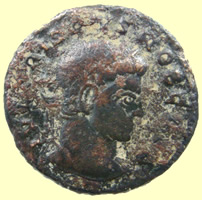


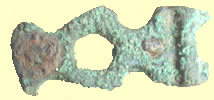


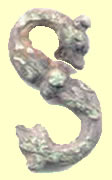
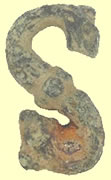
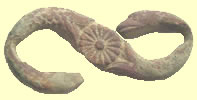
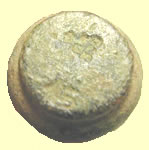


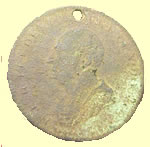

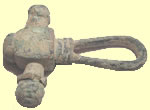
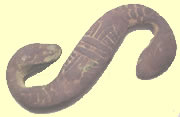
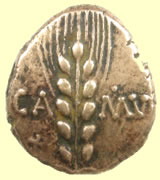
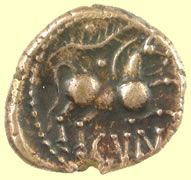
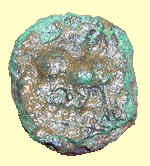
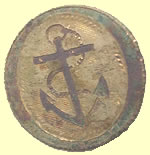
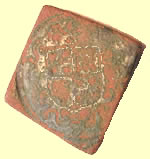
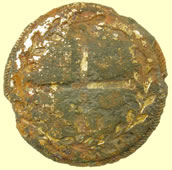

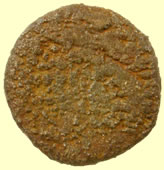
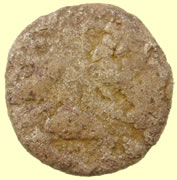
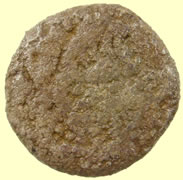


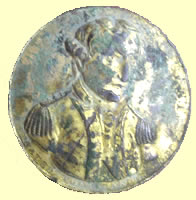
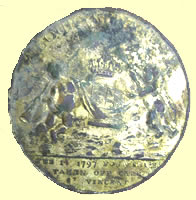
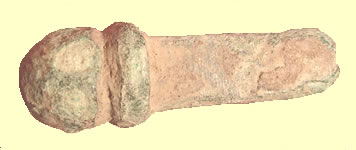

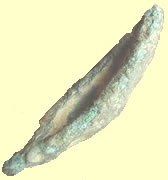

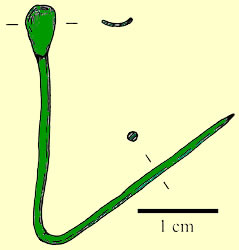

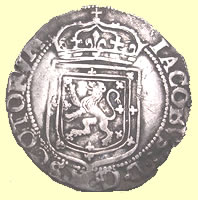
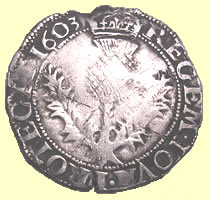
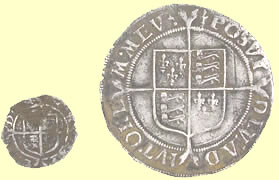
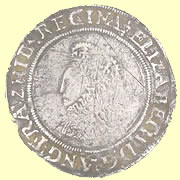

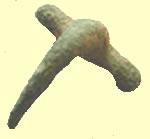


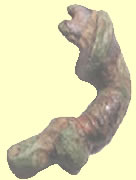
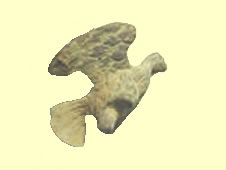
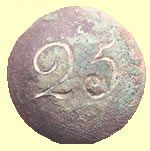
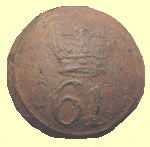
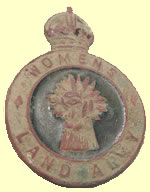
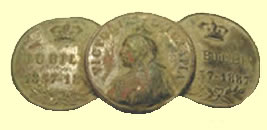

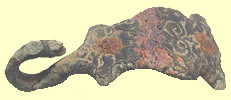


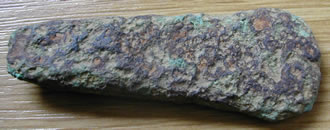

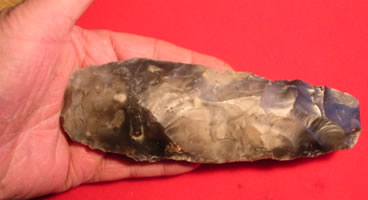
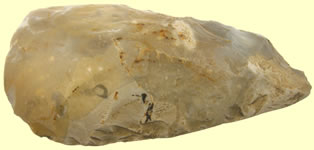
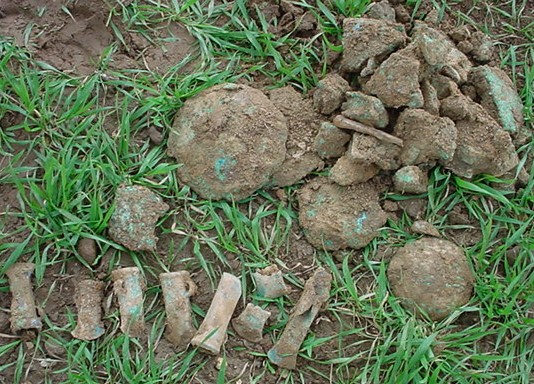


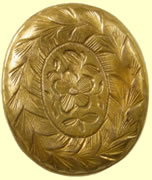

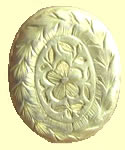
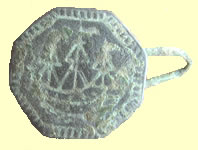
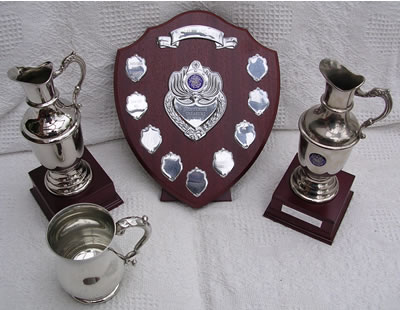 I dropped all this years
I dropped all this years 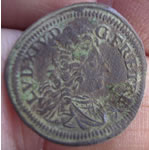
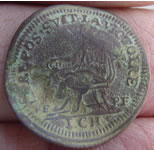
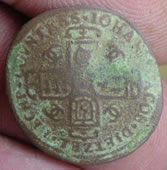
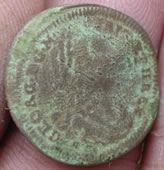

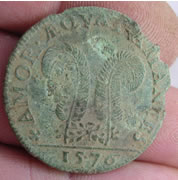
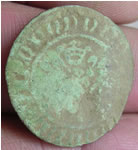
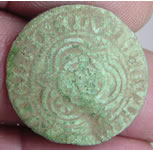
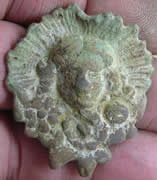
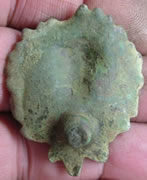

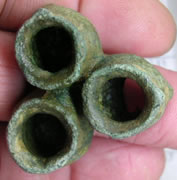
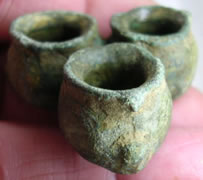
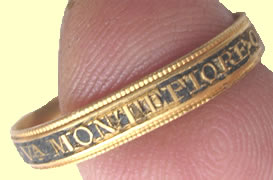

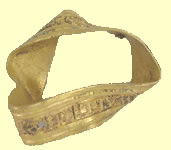
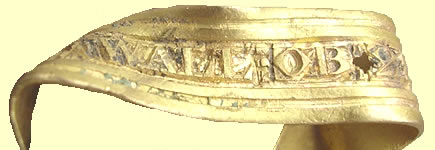

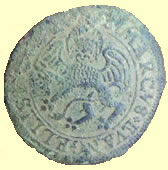
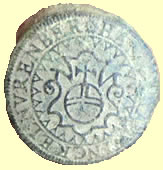
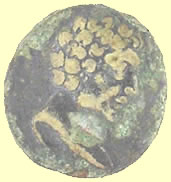
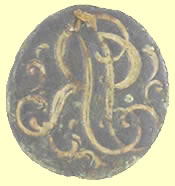
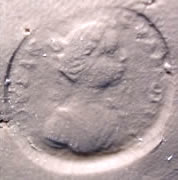

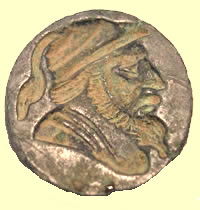
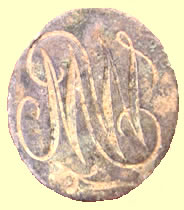


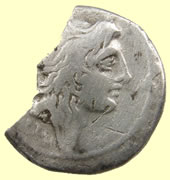

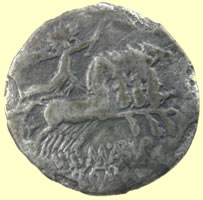
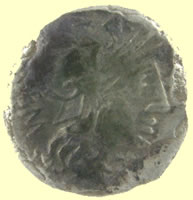
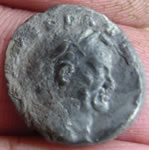
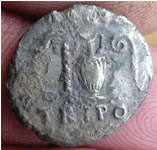
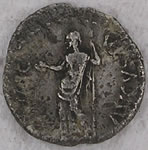
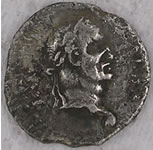
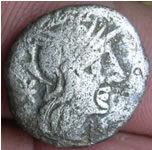

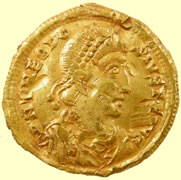
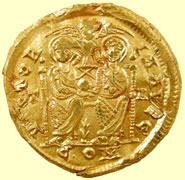
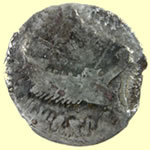
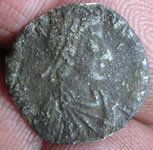


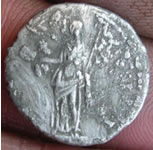
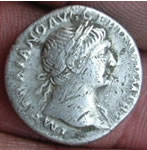
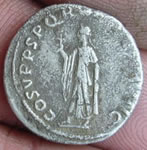





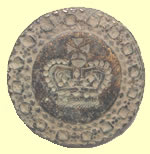

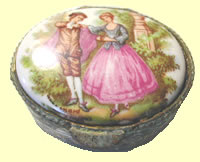
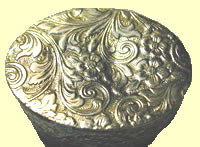



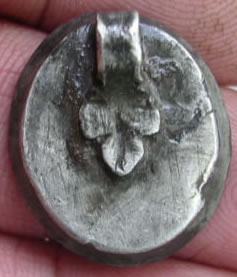
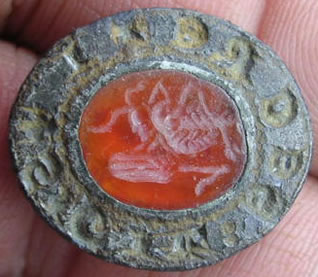



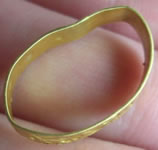



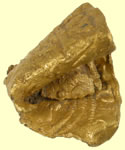
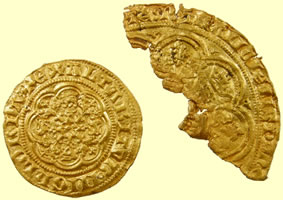
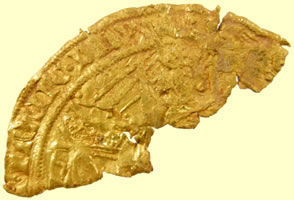
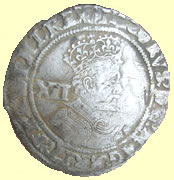
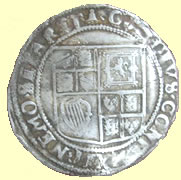


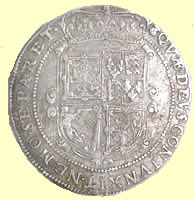
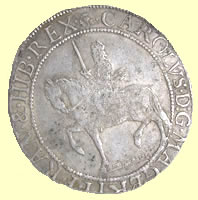
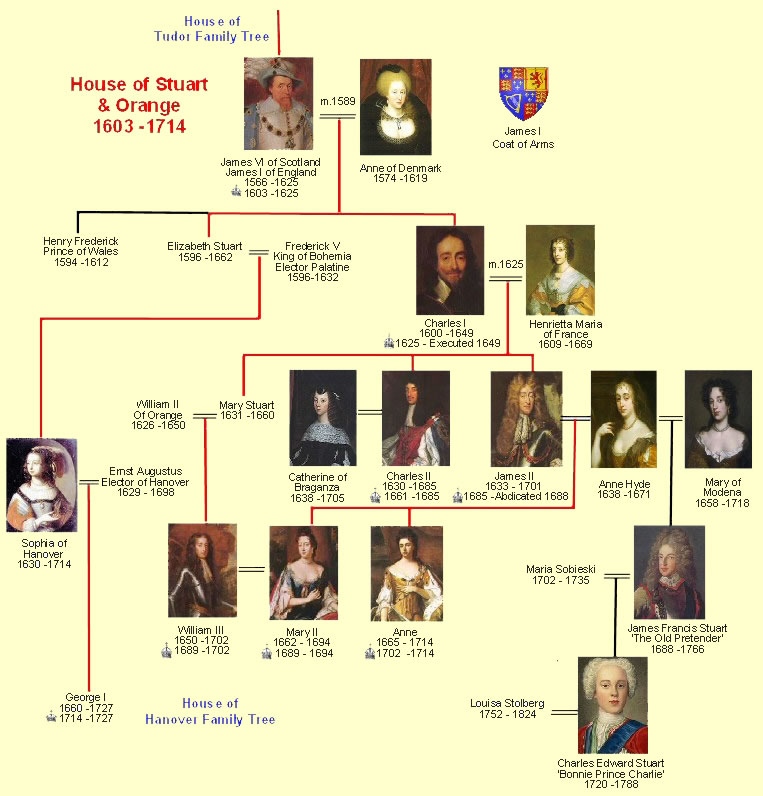
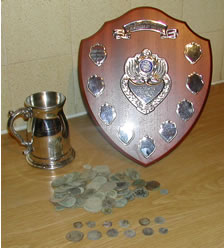
 'Hi Everyone,
Mitch King here, web master for the Team Garrett 2007 website.
'Hi Everyone,
Mitch King here, web master for the Team Garrett 2007 website.
